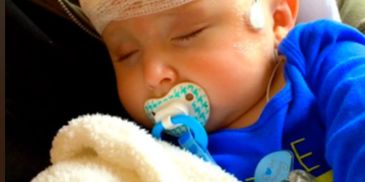Ohtahara syndrome

What is Ohtahara syndrome
What is Ohtahara syndrome
What is Ohtahara syndrome
Ohtahara syndrome (OS) is a rare form of epilepsy that occurs in infants. It is also sometimes called:
Early infantile epileptic encephalopathy (EIEE)
EEIE with burst suppression pattern (EIEE-BS)
OS is one of a group of developmental epileptic encephalopathies (DEEs). DEEs are epilepsy syndromes that impact development at an early age. Chil
Ohtahara syndrome (OS) is a rare form of epilepsy that occurs in infants. It is also sometimes called:
Early infantile epileptic encephalopathy (EIEE)
EEIE with burst suppression pattern (EIEE-BS)
OS is one of a group of developmental epileptic encephalopathies (DEEs). DEEs are epilepsy syndromes that impact development at an early age. Children with Ohtahara syndrome typically develop seizures within the first weeks or months of life. These seizures can be hard to control. Children with OS also have developmental delays.
Ohtahara syndrome can have different kinds of causes:
Structural abnormalities. Most often, OS is caused by differences in how the brain has developed before birth.
Metabolic disorders. This is a less common cause of OS.
Genetic mutations. This is a less common cause of OS.
childneurologyfoundation.org
Authors: Katherine Xiong, MD; Courtney J. Wusthoff, MD, MS
Division of Child Neurology, Stanford University

Signs and Symptoms
What is Ohtahara syndrome
What is Ohtahara syndrome
Children with Ohtahara syndrome have two primary symptoms:
- Seizures
- Developmental delays
Seizures
Timing
Children with Ohtahara syndrome develop frequent seizures within the first 3 months of life. They most commonly appear within the first 2 weeks after birth.
Severity
These seizures can be very difficult to control. They often require seve
Children with Ohtahara syndrome have two primary symptoms:
- Seizures
- Developmental delays
Seizures
Timing
Children with Ohtahara syndrome develop frequent seizures within the first 3 months of life. They most commonly appear within the first 2 weeks after birth.
Severity
These seizures can be very difficult to control. They often require several antiseizure medications.
Types of Seizures
OS is associated with several different types of seizures.
An EEG or long-term video EEG monitoring is often very helpful to:
- Identify all the seizure types taking place
- Identify the frequency of the seizures
- Decide if an episode is a seizure or not
Tonic seizures are the most common type of seizure in those with OS. Tonic seizures are also known as tonic spasms. They usually last only a few seconds. They may:
- Look like stiffening of the arms and/or legs
- Affect one or both sides of the body
- Occur alone or in clusters
- Occur when a baby is awake or asleep
Other types of seizures that can occur in OS include:
- Focal seizures. Focal seizures start in one area of the brain. They can cause abnormal movements in just one part of the body.
- Atonic seizures. Atonic seizures are also called “drop attacks.” They cause children to suddenly lose muscle tone. This causes them to go limp.
- Myoclonic seizures. This involves brief, shock-like jerks of a muscle or group of muscles.
- Generalized tonic-clonic seizures. These are also called “grand mal” seizures. They affect both halves of the brain. They begin with a sudden loss of alertness. This is followed by muscle stiffness and jerking movements.
Development
Infants with Ohtahara syndrome have developmental delays. This can be the result of the underlying cause of their condition in combination with ongoing seizures. They often do not reach milestones at the same age as other infants. They may also have abnormal results on a neurological exam. For instance, they may be:
- Less active
- Less alert
- Prone to low muscle tone (hypotonia)
Developmental symptoms may be present before seizures start. However, they can worsen as the seizures increase.
childneurologyfoundation.org
Authors: Katherine Xiong, MD; Courtney J. Wusthoff, MD, MS
Division of Child Neurology, Stanford University

Is there any treatment?
What is Ohtahara syndrome
Is there any treatment?
Several treatments can be used to treat OS. The treatments are focused on controlling the seizures caused by OS.
Antiseizure Medications
Seizures in OS are usually drug resistant. For this reason, many patients need to take more than one type of medication.
Epilepsy Surgery
Focal seizures are seizures arising from one area of the brain. In t
Several treatments can be used to treat OS. The treatments are focused on controlling the seizures caused by OS.
Antiseizure Medications
Seizures in OS are usually drug resistant. For this reason, many patients need to take more than one type of medication.
Epilepsy Surgery
Focal seizures are seizures arising from one area of the brain. In these cases, surgery might be able to help reduce seizures. This can involve either:
- The removal of one area of the brain (a focal resection)
- The removal of most of one side of the brain (a hemispherectomy)
When epilepsy surgery is successful, it can lead to improved developmental outcomes for some children.
KetoGenic Diet
When drugs and surgery can’t help with seizures, a ketogenic diet may be used. This special high-fat, low carbohydrate diet has been shown to control seizures in some children with epilepsy.
Vagus Nerve Stimulation (VNS)
VNS can be used for seizure control in some older children. VNS therapy involves implanting a device that can prevent or lessen seizures. It works by sending mild pulses of electrical energy to the brain through the vagus nerve.
Correcting Metabolic Problems
Some children have OS because of an underlying metabolic disorder. In these cases, treating that disorder can help improve seizures.
childneurologyfoundation.org
Authors: Katherine Xiong, MD; Courtney J. Wusthoff, MD, MS
Division of Child Neurology, Stanford University

Causes
More Information here
Is there any treatment?
Ohtahara syndrome can have several different causes.
- Brain malformations. Most cases of OS are due to abnormal brain development. These abnormalities can be:
- Diffuse. Affecting both sides of the brain. Most infants have diffuse brain abnormalities.
- Focal. Affecting only one area of the brain. This is less common.
- Genetic mutations. Genetic mu
Ohtahara syndrome can have several different causes.
- Brain malformations. Most cases of OS are due to abnormal brain development. These abnormalities can be:
- Diffuse. Affecting both sides of the brain. Most infants have diffuse brain abnormalities.
- Focal. Affecting only one area of the brain. This is less common.
- Genetic mutations. Genetic mutations can cause OS. This is because genetic differences can impact brain development or function.
- Metabolic disorders. Metabolic disorders can cause OS. They can impact how the body and brain use energy. This can lead to abnormal brain function and seizures.
Sometimes no clear cause is found, even after exams and testing. Cases in which there is no known cause are called idiopathic cases.
childneurologyfoundation.org
Authors: Katherine Xiong, MD; Courtney J. Wusthoff, MD, MS
Division of Child Neurology, Stanford University
Outlook
More Information here
More Information here
There is no cure for Ohtahara syndrome. Treatment focuses on controlling seizures as much as possible and supporting development. Even with treatment, most children with OS will have seizures throughout their lifetime. Further, these seizures will be difficult to control.
Many children will have different types of seizures when they are ol
There is no cure for Ohtahara syndrome. Treatment focuses on controlling seizures as much as possible and supporting development. Even with treatment, most children with OS will have seizures throughout their lifetime. Further, these seizures will be difficult to control.
Many children will have different types of seizures when they are older than they did when they were younger. Some will progress to having additional epilepsy syndromes, such as:
Some children will experience significant complications from OS or from its underlying cause. These children may die within the first two years of life.
Children who survive into childhood typically have severe physical and cognitive disabilities. They usually require a lot of assistance to perform the tasks of daily life. They may need help with eating or dressing. They may benefit from:
- Special educational support
- Physical and occupational therapy
- Speech and language therapy
childneurologyfoundation.org
Authors: Katherine Xiong, MD; Courtney J. Wusthoff, MD, MS
Division of Child Neurology, Stanford University
Smiles from Joey
This website uses cookies.
We use cookies to analyze website traffic and optimize your website experience. By accepting our use of cookies, your data will be aggregated with all other user data.
